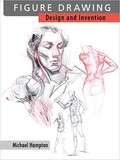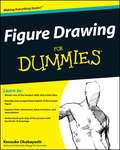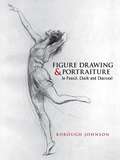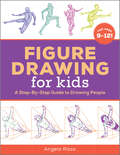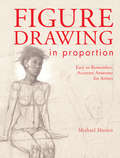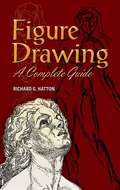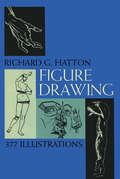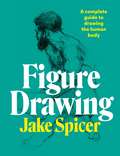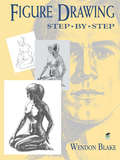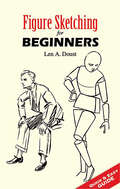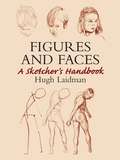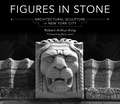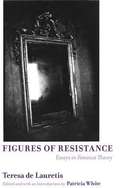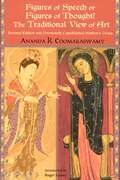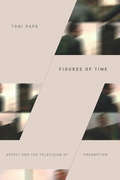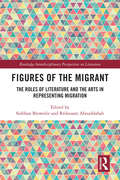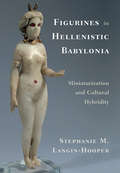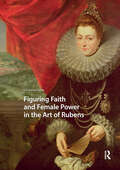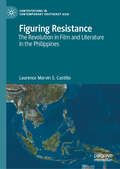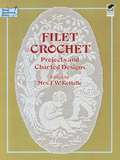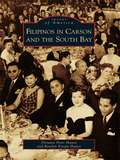- Table View
- List View
Figure Drawing
by Michael HamptonFigure Drawing: Design and Invention is an instructional figure drawing book geared towards the novice and experienced artist alike. This book emphasizes a simplified understanding of surface anatomy, in order to clarify the mechanics of the figure, facilitate invention, and ultimately create a skill-set that can be successfully applied to other media. In addition, this book focuses very strongly on practical usage, making sure the artist is able to assimilate the steps presented here into a cohesive working process. (Fourth printing, September 2011)
Figure Drawing For Dummies
by Kensuke OkabayashiFigure Drawing For Dummies appeals to both new art students and veteran artists who find it difficult to proportionally draw the human form. The illustrations and examples in Figure Drawing For Dummies are designed to help readers capture this elusive figure.
Figure Drawing Master Class: Lessons in Life Drawing
by Dan GhenoWith Figure Drawing Master Class, you will discover the secrets to creating masterful figure drawings through examples of Old Master drawings, as well as Dan Gheno's own beautiful drawings, demonstrations and diagrams.This take-home course covers everything you need to put yourself on the fast-track to successful figure drawing.Inside you'll find:The basics of training your hand to drawGesture drawing lessonsHow to draw heads and handsHow to accurately compose your figuresKeys to replicating the subtle details in the posture of the head to suggest emotionThe basics of human proportionsWith tips, tricks and historical references, the drawing instruction inside will help you with all the critical skills you need to travel your own journey through successful figure drawing and improve your drawings for years to come.Learn to draw all aspects of the human figure with diagrams, demonstrations and Old Master drawingsMore than 120 drawings by Old Master artists including Michelangelo, Leonardo, Raphael and RembrandtIncludes 5 step-by-step demonstrations to reinforce the key concepts of figure drawing
Figure Drawing and Portraiture: In Pencil, Chalk and Charcoal
by Borough JohnsonFrom an award-winning English artist and teacher whose work was exhibited at the esteemed Paris Salon and London's Royal Academy comes a beautifully designed guide to drawing the face and figure. The author of such artistic references as "The Technique of Pencil Drawing" and "The Art of the Pencil," Borough Johnson also illustrated many famous poems and novels, including Longfellow's "Evangeline" and Hardy's Tess of the D'Urbervilles."Art cannot be taught. Drawing, like science, can." With those opening words, Borough Johnson takes a creative step forward, demonstrating how to draw the human figure with shading and texture, using pencil, chalk, and charcoal. In easy-to-follow terms, he explores the most important aspects of drawing the human form: anatomy, proportion, composition, motion, drawing from memory, and capturing emotion with an economy of line. He also offers eighty-two of his own compositions in black-and-white--subjects that include a ballerina, fencer, gypsies, violinist, children playing, and more--to illustrate his lessons. Eight color plates (red chalk drawings) are also included. Perfect for intermediate and advanced students who want to improve their skills, Figure Drawing and Portraiture is a valuable guide for every artist's reference shelf.
Figure Drawing for Kids: A Step-by-Step Guide to Drawing People (Drawing Books for Kids Ages 9 to 12)
by Angela RizzaAn easy guide to drawing people for budding artists ages 9 to 12Grab a pencil and an eraser—it's time to explore the world around you and illustrate the people in it! Featuring a step-by-step format for beginners, Figure Drawing for Kids is a great way to start sketching friends and family, pop culture icons, and epic superheroes—one simple exercise at a time.Project-based activities—Learn how to draw people with 13 different projects that will advance your skills from basic shapes and shading to full, detailed illustrations.Guided practice—Explore essential drawing concepts like proportion, negative space, point of view, composition, and crosshatch, and practice with a range of human sizes, shapes, skin tones, and abilities.Bonus drawing tips—Learn to draw from life or a photograph, how to set up a model station, and how to complete your drawings with additional objects and landscape elements.Dive in and let the doodling fun begin with this beginner's guide to drawing for kids.
Figure Drawing in Proportion: Easy to Remember, Accurate Anatomy for Artists
by Michael MassenAn intuitive approach for figure artists to get proportions right. Traditional methods of measuring body proportions rely on the abstract memorization of convoluted fractions or multiples of the human head. But artists shouldn't have to be mathematicians. Figure Drawing in Proportion introduces a better, more intuitive, less intimidating way to get proportions right. It starts with the revelation that--despite the wonderful variety of bodies in this world--the human figure has standard size relationships artists can build upon for accurate renderings. If you know, for example, that the collarbone is the same width as the head, it's much easier to draw the head in proper relationship to the shoulders. Knowing that the palm should be the same width as the knee helps establish the correct relationships in a seated portrait. This book highlights dozens of such key internal and comparative measurements. Once you start looking, you will discover even more. Ideal for any level of artist, this practical approach to proportions makes figure drawing more approachable and more rewarding. Inside you'll find:9 full step-by-step demonstrations, using various poses and figures to show proportioning techniques in practice.Internal and comparative measurements and how to apply them to figure drawings.Simple strategies for recalling key proportions as you work.
Figure Drawing: A Complete Guide
by Richard G. HattonOne of the few available guidebooks of its kind, this manual approaches figure drawing from the draftsman's point of view. With a clear focus on surface lines and prominences, step-by-step instructions and over 300 illustrations guide artists in accurately sketching all aspects of the human form in lively action and repose.Beginning with method and proportion, the author discusses the drawing of lines, contours, planes, masses, and rounded forms. Moving on to the individual parts of the body, simple principles of anatomy are applied to demonstrate techniques for sketching the head and neck, the trunk, the upper and lower limbs, and the digits. Expertly rendered figures are shown in various positions and movements, and from all angles, for the most thorough, concise instruction. Brimming with the basic elements necessary for creating quality works of art, Figure Drawing also includes guidance for drawing drapery, revealing the main points of support on the body and the proper way to sketch the folds and forms of garments. Immensely practical and highly readable, it is a manual that artists of every level will turn to again and again.
Figure Drawing: A Complete Guide (Dover Anatomy for Artists)
by Richard G. HattonWhile there are any number of anatomy texts and handbooks for artists, this is one of the few available studies that approach the art of figure drawing from the point of view of the draftsman. Though it does provide a fund of information on all important anatomical features and functions, the book stresses how the figure-sketcher should handle his subject, how he should actually put down surface lines and prominences on paper. It is an immensely practical guide for the student. The text covers all aspects of drawing the human form. An important introductory section deals with methods of drawing and the proper proportioning of the body. Then the author treats the various parts of the body in full detail: head and neck (over 100 pages on facial features, etc.), the trunk (chest, abdomen, vertebral column, breast, pelvis, shoulders, etc.) and the upper and lower limbs and digits. A final discussion takes up the topic of drapery, the main points of support on the body, and various styles of representing the folds and forms of garments. Three hundred seventy-seven figures, mostly sketches by the author, but including some examples from classical times and famous artists, illustrate the text. These figures show undraped men and women of all ages and types in various positions and movements and from all angles (full front view, profile, three-quarter view, rear view, etc.) so that the coverage is as thorough as possible for the student. Other drawings show and identify muscles and elements of the skeletal system and indicate their relation to surface contours. A clear and readable account with many helpful suggestions on sketching technique, the book offers a nontechnical, inexpensive home-study course or supplementary text for the beginning artist. Those art students who derive little or no benefit from anatomy courses would do well to study this volume. Unabridged, unaltered republication of original edition.
Figure Drawing: A complete guide to drawing the human body
by Jake SpicerInformative and instructive, this comprehensive guide will give you all the tools you need to draw the human figure, from life and from a screen. While many books focus on just one aspect of figure drawing, this manual unites the skills of observation, expression and understanding in one coherent approach. Beginning with the key principles of observation, Figure Drawing will help you to build a strong foundation of skills to make well-observed, proportionally accurate drawings. As the book progresses you will explore processes and exercises that move beyond the purely observed to express the gesture, form and substance of your model.Photographic and illustrative examples throughout the book support your learning at every step. Clear step-by-step tutorials provide a practical understanding of the key materials, skills and ideas in figure drawing. A comprehensive anatomical reference section, broken down into manageable zones, deepens your knowledge of the human form. The book is a Swiss-bound paperback, designed to lie flat when open and in use.
Figure Drawing: A complete guide to drawing the human body
by Jake SpicerInformative and instructive, this comprehensive guide will give you all the tools you need to draw the human figure, from life and from a screen. While many books focus on just one aspect of figure drawing, this manual unites the skills of observation, expression and understanding in one coherent approach. Beginning with the key principles of observation, Figure Drawing will help you to build a strong foundation of skills to make well-observed, proportionally accurate drawings. As the book progresses you will explore processes and exercises that move beyond the purely observed to express the gesture, form and substance of your model.Photographic and illustrative examples throughout the book support your learning at every step. Clear step-by-step tutorials provide a practical understanding of the key materials, skills and ideas in figure drawing. A comprehensive anatomical reference section, broken down into manageable zones, deepens your knowledge of the human form. The book is a Swiss-bound paperback, designed to lie flat when open and in use.
Figure Drawing: Step by Step
by Wendon BlakeSince ancient times the nude figure has been painted, sculpted, and drawn by countless artists. Today, art instructors still maintain that drawing the nude is the best way to perfect drawing skills, This abundantly illustrated guide provides students with all the information they need to portray the human figure skillfully.Noted artist and art teacher Wendon Blake begins by showing students how to establish proportions; he then provides helpful suggestions for drawing torsos, heads, arms and hands, legs and feet. This is followed by detailed instructions for depicting ten complete figures. Step-by-step demonstrations show you how to draw simple subjects such as standing and seated figures, as well as figures in more complex poses (bending, kneeling, twisting, and crouching). Students will also learn how to establish major forms, refine lines for increased accuracy, block in broad shadow areas, and finish the work by polishing contours, strengthening shadows, and adding details. Some 170 illustrations covering a variety of pencil, chalk, and charcoal techniques not only present every drawing operation in precise detail but also reveal how to develop form, light, and shade by combining lines, strokes, and blended tones. Beginners will appreciate this volume's clear instructions, practical advice, and detailed illustrations, while more experienced artists will find it an excellent review of the basics and a source of valuable insights.
Figure Sculpture in Wax and Plaster
by Richard MillerStep-by-step guide to materials and tools, modeling in wax and plaster, hollow wax modeling, plaster molds, and much more. Introduction. "The beginning artist will find the step-by-step instructions...to be like having a personal tutor." -- Enchantment. 281 photographs.
Figure Sketching for Beginners
by Len A. DoustIf a drawing "is not alive, it is a failure," declares Len A. Doust. With his practical help and encouraging guidance, even novice sketchers can learn how to capture the vitality and character of their models.Clear instructions and 23 step-by-step illustrations highlight everything students need to know. Featured topics include:* Perspective and proportions* Heads, faces, and hands* Hats, shoes, and clothing* Age and character* Expressions* Athletes and dancersConcise and informative, this manual offers sketchers the perfect way to get started.
Figures and Faces: A Sketcher's Handbook (Dover Art Instruction)
by Hugh LaidmanArtist, illustrator, and teacher Hugh Laidman shows how simple and rewarding it can be to draw two of the most challenging of artistic subjects -- the male and female figures.A brief review of anatomical structure is followed by detailed illustrations and clear instructions for rendering line, tone, structure, and form in a variety of techniques. Explanatory drawings, practice exercises, and step-by-step photographs are used to discuss sketching, sustained and contour drawing, working with charcoal or pastels, as well as finding and posing models and drawing people of different ages and ethnic groups. Art students to professionals will find the text's direct terminology and detailed illustrations of immense value.
Figures in Stone: Architectural Sculpture in New York City
by Robert Arthur KingA delightful collection of quirky faces, figures, and creatures that adorn New York City buildings. This gift-sized and attractively priced book for architecture buffs features more than two hundred imaginative sculptural details, from the domestic to the fantastic, with a brief introduction and contextual photos to show the building on which each ornament appears, the addresses, and transportation information. Contains the complete contents of King’s Faces in Stone and Animals in Stone, available for the first time in one decisive volume.
Figures of Resistance: Essays in Feminist Theory
by Patricia White Teresa De LauretisThe changing face of feminist discourse as reflected by the career of one of its preeminent scholars Figures of Resistance brings together the unpublished lectures and little-seen essays of internationally renowned theorist Teresa de Lauretis, spanning over twenty years of her finest work. Thirty years after the height of feminist theory, this collection invites us to reflect on the history of feminism and take a hard look at where it stands today. Selected essays include "Sexual Indifference and Lesbian Representation," "The Lure of the Mannish Lesbian," "Eccentric Subjects," "Habit Changes," "The Intractability of Desire," and the unpublished article "Figures of Resistance." An introduction from feminist film scholar Patricia White provides an overview of the development of de Lauretis's thought and of feminist theory over past decades.
Figures of Speech or Figures of Thought?: The Traditional View of Art, Revised Edition with Previously Author's Unpublished Notes
by Ananda K. CoomaraswamyThis new edition of Coomaraswamy's classic book, considered his most important work on the philosophy of art, includes all of the revisions Coomaraswamy had wanted to add to the original edition.
Figures of Time: Affect and the Television of Preemption (Thought in the Act)
by Toni PapeMany contemporary television series from Modern Family to How to Get Away with Murder open an episode or season with a conflict and then go back in time to show how that conflict came to be. In Figures of Time Toni Pape examines these narratives, showing how these leaps in time create aesthetic experiences of time that attune their audiences to the political doctrine of preemption—a logic that justifies preemptive action to nullify a perceived future threat. Examining questions of temporality in Life on Mars, the political ramifications of living under the auspices of a catastrophic future in FlashForward, and how Damages disrupts the logic of preemption, Pape shows how television helps shift political culture away from a model of rational deliberation and representation toward a politics of preemption and conformity. Exposing the mechanisms through which television supports a fear-based politics, Pape contends, will allow for the rechanneling of television's affective force into building a more productive and positive politics.
Figures of the Migrant: The Roles of Literature and the Arts in Representing Migration (Routledge Interdisciplinary Perspectives on Literature)
by Siobhan Brownlie and Rédouane AbouddahabThis volume seeks to investigate the representation of the migrant and migration in literary texts and the arts. Through studies that examine works in a range of art forms ‒ novels, theatre, poetry, creative non-fiction, documentary films, and performance and video installations ‒ that evoke a variety of historical and (trans)national contexts, the volume focuses on the question of the roles of literature and the arts in representing migration. An important issue considered is the extent to which artistic figuration can act as a counterpoint to social discourse on migrants that often involves stereotypes and reductive views. The different contributions to the volume illustrate that literature and the arts can provide readers and viewers with a space for fluid knowledge production and affective expansion, and that within that overarching function, artistic works play three main roles with regard to representing migration: undertaking a socio-political and cultural critique, presenting alternative views to stereotypes that highlight the singularity and complexity of the migrant, and providing proposals for different futures.
Figures, Faces & Folds: Women's Form and Dress for Artists, Students and Designers
by Adolphe Armand BraunRanging from classical to contemporary eras, this art instruction manual presents a historical overview of the depiction of women in drawings, paintings, sculpture, and photography. The highly detailed study is generously illustrated with black-and-white photographs, line drawings, and reproductions of paintings by Botticelli, Rubens, Vermeer, and other masters. More than 100 reference photos, referred to as "The Standard Poses," offer an additional resource for figure study. Suitable for intermediate to advanced students of art, the two-part treatment examines modes of dress and their appearance in art, followed by the reference photos. Topics range from drapery studies and the structure of dress to the anatomy of the body and the skeleton. Contemporary poses portray all aspects and positions of the body in action as well as repose and include a section on hands and gloves.
Figurines in Hellenistic Babylonia: Miniaturization and Cultural Hybridity
by Stephanie M. Langin-HooperIn this volume, Stephanie M. Langin-Hooper investigates the impact of Greek art on the miniature figure sculptures produced in Babylonia after the conquests of Alexander the Great. Figurines in Hellenistic Babylonia were used as agents of social change, by visually expressing and negotiating cultural differences. The scaled-down quality of figurines encouraged both visual and tactile engagement, enabling them to effectively work as non-threatening instruments of cultural blending. Reconstructing the embodied experience of miniaturization in detailed case studies, Langin-Hooper illuminates the dynamic process of combining Greek and Babylonian sculpture forms, social customs, and viewing habits into new, hybrid works of art. Her innovative focus on figurines as instruments of both personal encounter and global cultural shifts has important implications for the study of tiny objects in art history, anthropology, classics, and other disciplines.
Figuring Faith and Female Power in the Art of Rubens (Visual and Material Culture, 1300-1700)
by J. Vanessa LyonFiguring Faith and Female Power in the Art of Rubens argues that the Baroque painter, propagandist, and diplomat, Peter Paul Rubens, was not only aware of rapidly shifting religious and cultural attitudes toward women, but actively engaged in shaping them. Today, Rubens's paintings continue to be used -- and abused -- to prescribe and proscribe certain forms of femininity. Repositioning some of the artist's best-known works within seventeenth-century Catholic theology and female court culture, this book provides a feminist corrective to a body of art historical scholarship in which studies of gender and religion are often mutually exclusive. Moving chronologically through Rubens's lengthy career, the author shows that, in relation to the powerful women in his life, Rubens figured the female form as a transhistorical carrier of meaning whose devotional and rhetorical efficacy was heightened rather than diminished by notions of female difference and particularity.
Figuring Resistance: The Revolution in Film and Literature in the Philippines (Contestations in Contemporary Southeast Asia)
by Laurence Marvin CastilloThis book examines how fiction films and novels represent the communist-led national democratic (NatDem) revolution in the Philippines. Produced aboveground decades after the Philippines’ historic transition from dictatorship to elite democracy, these NatDem fictions depict how the communist movement in the Philippines confronted various national and global changes, tracking revolutionary experiences amidst the ascendancy of neoliberalism, the continuation of counterinsurgency and the emergence of non-Marxist social movements and discourses. Figuring Resistance studies how fictions portray the tenacity of political commitment among revolutionaries engaged in the revolution's manifold history of crises, setbacks, and persistence. It illuminates the crucial role played by cultural work in creating and nourishing an oppositional public sphere, where the experiential makings of the liberation struggle in the Third World can be imagined.
Filet Crochet: Projects and Charted Designs (Dover Knitting, Crochet, Tatting, Lace Ser.)
by F. KettelleFilet crochet is a simple method of producing beautiful lace by crocheting closed and open squares.This book includes complete instructions for working the squares plus tables, materials, and charts for over fifty projects such as doilies, table cloths, a lampshade, centerpieces, borders and insertions, panels for pillows and bedspreads, baby items, a tray, coffee cloths, and luncheon cloths.Each pattern has a photographs of the finished article, close-up photos of detail work, indications of the amount of thread, and the size of the crochet hook to use.|Crocheters will welcome this unique collection of hard-to-find patterns. They can be used as is, in combination, or as a source to develop your own unique ideas. The charts can be used for cross-stitching, latch-hooking, knitting, or any other forms of counted thread embroidery.
Filipinos in Carson and the South Bay (Images of America)
by Florante Peter Ibanez Roselyn Estepa IbanezOne of Carson's most distinct features is its diversity. The city is roughly one-quarter each Hispanic, African American, white, and Asian/ Pacific Islander. This last group's vast majority are Filipinos who settled as early as the 1920s as farmworkers, U.S. military recruits, entrepreneurs, medical professionals, and other laborers, filling the economic needs of the Los Angeles region. This vibrant community hosts fiestas like the Festival of Philippine Arts and Culture and has produced local community heroes, including "Uncle Roy" Morales and "Auntie Helen" Summers Brown. Filipino students of the 1970s organized to gain college admissions, establish ethnic studies, and foster civic leadership, while Filipino businesses have flourished in Carson, San Pedro, Wilmington, Long Beach, and the surrounding communities. Carson is recognized nationally as a Filipino American destination for families and businesses, very much connected to the island homeland.
